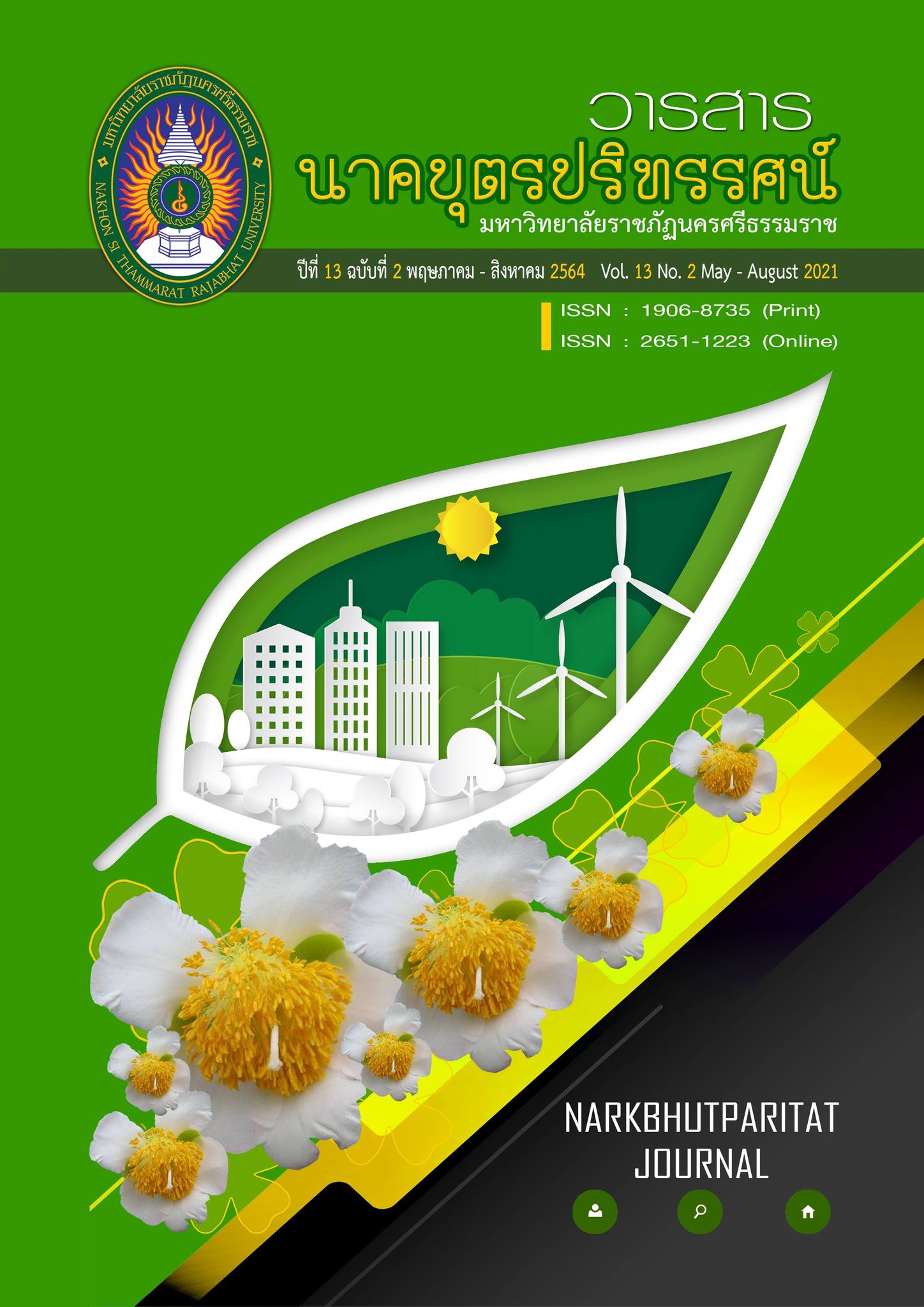Cultural Area of Burmese Migrant Workers in Surat Thani Province
Main Article Content
Abstract
This research aimed to study the construction of cultural areas and the religious identity and beliefs of the Burmese migrant workers in Surat Thani Province. This qualitative study collected data from relevant documents, the fieldwork and the informant group consisted of 55 Burmese migrant workers, experts and general informants, using the purposive method of selecting informants and presenting the results of the data analysis by descriptive analysis. The research findings indicate that, firstly, the Burmese migrant workers construct cultural areas in Surat Thani Province in four aspects: 1) occupation 2) religion and beliefs 3) recreational activities and 4) networking. Secondly, Burmese migrant workers represent their beliefs and religious identity in four features, such as 1) building pagodas in Burmese architectural style 2) making merit 3) showing respect to “Nat” (god-like spirits) and 4) dressing in Burmese style. Creating a cultural area and showing Burmese identity is a way to preserve and Continuing to maintain the Burmese identity in the cross-border area.
Article Details
References
Aow. (2016). Interview, 18 April 2016. (in Thai)
. (2018). Interview, 10 April 2018. (in Thai)
Appadurai, A. (1996). Modernity at Large : Cultural Dimensions of Globalization. Minneapolis: University of Minnessota Press.
Balcaite, I. (2019). Networks of Resilience: Legal Precarity and Transborder
Citizenshipamong the Karen from Myanmar in Thailand. Seoul. SogangUniversity.
Boonkamnerd, S. (2018). Interview, 15 May 2018. (in Thai)
Chalamwong, Y. (2007). A Study of The Real Need of Workers and Migrant Workers Management in Agriculture Fisherman Continuing Work of Fisherman and Construction. Bangkok: Research Institute of Thailand Development. (in Thai).
Changmong, P. (2016). Interview, 2 June 2016. (in Thai)
Cho-u, T. (2018). Interview, 22 April 2018. (in Thai)
Chu, T. (2018). Interview, 26 March 2018. (in Thai)
Ek-iam, B. (2019). Transnational Migration Building and Maintianing Social Networking of
Burmese Famale Migrants in Chiang Mai. .Journal of Civilization Studies,
Mekong-Salween, 10(1),12-38. (in Thai)
Fah. (2018). Interview, 3 June 2018. (in Thai)
Foreign Workers Administration Office, 2016, Data on the number of migrant workers of three nationalities. Retrieved 2017, April 5, from https://www.doe.go.th/) (in Thai)
Foreign Workers Administration Office. (2018). Employment statistics of aliens in 2013-2017. Retrieved 2018, April 1, from https://www.doe.go.th/ (in Thai)
Ganjanapan, A. & Samniang, C., (2014). Immigrant’s Workers, Identity and Citizenship. Chiangmai: Institute of Public Policy Chiangmai University. (in Thai). September 20. form https://prachatai.com/journal/2008/11/18969. (in Thai)
Jamrasridthirong, A., Panphung, S., Holamyong, J., Jamjan, C., Apipornchaisakul, G., and
Kaikeaw, S., (2016). Social Application Form of Immigrant’s Workers in Thailand. In Citizen and Social. (p. 52-75). Nokhonpathom: Research Institute of Citizen and Social Mahidol University. (in Thai)
Jo. (2018). Interview, 15 March 2018, 22 July 2018. (in Thai)
Kantasarapiwat, P. (2016). Interview, 22 February 2016. (in Thai)
. (2016). Interview, 27 August 2016. (in Thai)
Keaw-on, P. (2018). Interview, 25 April 2018. (in Thai)
Kerdmongkol, A. (2008). Immigrant Workers from Myanmar with Mobile Phone Used : Social Networking, Power, and Nigotiation. Journal of Prachathai. Retrieved 2019.
September 20, from https//prachatai.com/journal) (in Thai).
Narasaj, W. (2005).Tamil Elam: National Problems in Srilangka. Journal of History.
Retrieved 2019, November 18, From www.ejournals.swu.ac.th. (in Thai).
Niyomtham, W. (2015). Thai Image in Myanmar’s View.. booklet of Study Security 157.
Bangkok: Study Security Project National Intelligence Agency. (in Thai).
Office of the National Economics and Social Development Council. (2016). 8th National
Economic and Social Development Plan (2018-2021). Bangkok: Policy and Planning Division. (in Thai)
Opap, Worasit., Kaewnet, S., Topinjai, B. & Prapatthong, P. (2006). Cultural Areas in Multi- Ethnic Communities: The Case of Ban Huai Nam Khun Mae Fah Luang District Chiang Rai Province. (Research Report). Chiang Rai: Chiang Rai Provincial Cultural Office. Retrieved 2020, October 10, from http//research.culture.go.th. (in Thai)
Phetkeaw, C. (2017). Community Contex Economic Economic Base and CulturalCapital
Suratthani: The Meaning in Development. in Southern Culture and Economy. Bangkok: Dansutthakanpim. (in Thai).
Panangkaew, Y. (2018). Interview, 9 September 2018. (in Thai)
Phokapanichwong, N. (2013). Connecting process (Crossing Locations): Interaction of People in border towns and meaning negotiation through religious areas/ Communities of cross-border immigrants Burma in Ranong Province. Doctor of Philosophy. Thammasat University. (in Thai)
Raleuk, K. (2013). Phumcharon: Reconstruction Management Identity constructing of Border Community from Cultural Society to Thai Community with Cambodian’s Mind. Journal of Lumnamkhong 9(2): 139 - 166. Retrieved 2019, November 18,from https://mekongjournal.kku.ac.th/.(in Thai).
Samnieng, C. (2016). Life Area of Tai Yai Migrant Workers: Identity Constructing and Citizen of Cultural Area. in Seminar on Review Debate about twenty Century of Thai Lanna’s Knowledge : Chiang Mai University 2016, 1-28. Retrieved 2019, November 20, from https//www.academia.edu/23550473. (in Thai)
Santasombat, Y. (2008). Power Area and National Identity Politic Culture of National State in Thai Society. Bangkok: Julalongkorn University Book Center. (in Thai).
Samuphan, P. (2016). Interview, 25 May 2016. (in Thai)
Satiwaro, A., Hongtong, T., Boonyama, S., Warinto, W., & Chea-earb, S., (2018). Buddhist’s Group Behavior of Myanmar Migrant Workers with a Quality of Life Development in Samutsakhon
Province. Journal of Santiseuksanparithat MCU. 6(3), 1212-1228. (in Thai)
Sarnsutthakhun, P. (2018). Interview, 26 March 2018. (in Thai)
Somboon, W. (2010). State-Nationality, Nation: Notice on Nation, State, and National
Problems. Bangkok: Assumptions. (in Thai)
Sophaphon, W. (2019). Cross Over Merit Function: Renew Self Adjustment and Myanmar Nationality Immigrant Workers’ Negotiation in Khonkan Province. Journal of Suratthani Rajabhat University. 6(1): 95-112. (in Thai)
Thepsing, P. (2019) The Method characteristics to Reserve Cultural Legacy of Buddhism Natham Sub district Yala Province. Journal of Humanities and Social Sciences Burapha University. 27(53), 23-46. (in Thai)
Tin-ong, M. (2008) A History of Burma. Translated by Phetri Sumit. Bangkok: Social Sciences and Humanities Book Project Foundation. (in Thai).
Visalo, P. (2003) Thai Buddhism in the Future Trend and Solution for the Crisis. Bangkok: Sodsri- Saridwong Foundation. (in Thai)
Wasee, P. (2004). The Development need to lead by Culture. Bangkok: Mochaoban Press. (in Thai)
Yanyongkasemsuk, R., (2012). Willing of the Past: The Past in the Modern Society. Journal of Politic, Adminitration and Law. 4(2), 64-70, Retrieved 2019, December 15. from www.opac.lib.buu.ac.th. (in Thai)


